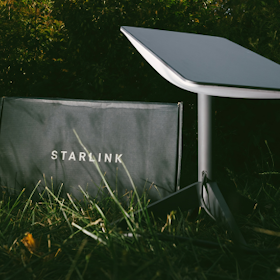
Satellite internet uses satellites in the sky to provide you with an internet connection. Because the signals have to travel such long distances (about 44,000 miles roundtrip), satellite internet tends to have slower internet speeds and a longer latency than DSL, cable, and fibre. That said, satellite internet reaches virtually everywhere, making it a great choice for customers living in rural areas.
The main satellite internet providers in Canada are Galaxy Broadband, Xplore, and SpaceX’s Starlink, which is now available in most of Canada.
Satellite internet covers those hard-to-reach places in Canada where wired connections aren’t available. This guide includes everything you need to know about satellite internet—what it is, how it works, what kind of speeds it offers, and how it’s installed.
Satellite Internet Overview
| Internet Speeds | 12-100Mbps |
|---|---|
| Latency | 600 – 800 ms |
| Price | $79.99-$140/month |
| Availability | Virtually everywhere |
| Reliability | May be unreliable due to weather, weak signal, and obstructions |
| Best for | Rural customers who don’t have access to wired connections |
Satellite internet explained
Satellite internet is one of the four types of internet connections available in Canada, with the others being cable, DSL, and fibre internet. Satellite internet provides customers with an internet connection via a satellite dish, as opposed to cables. Because satellite internet doesn’t require wires and instead relies on a satellite orbiting the Earth, you are able to get an internet connection in even the most rural of locations.
The biggest advantage of satellite internet is its widespread coverage, reaching parts of the country that cable, DSL, and fibre don’t reach. This allows customers in rural areas to have internet access, which helps close the digital divide between rural and nonrural individuals and families.
On the flip side, a major disadvantage of satellite internet service is its slow internet speeds—satellite internet has the slowest download speeds of the four main internet connection types, and the gap is pretty big, with cable, DSL, and fibre offering speeds up to 40 times faster.
How does satellite internet work?
Satellite internet is fairly easy to understand. Here’s how it works:
- Your device (computer, smartphone, smart TV, or tablet) sends a signal to your modem.
- Your modem sends the signal to your satellite dish.
- From your dish, the signal goes to your provider’s satellite, which is about 22,000 miles from Earth.
- Your provider’s satellite transmits the signal to its server.
How does latency affect your satellite internet connection?
Satellite internet is notorious for having the longest latency periods, with most satellite plans falling somewhere between 600 milliseconds and 800 milliseconds. The only exception is Starlink, which promises a ping as low as 25 milliseconds, which, if true, is comparable to fibre internet’s latency.
For comparison, the typical internet user is going to want a ping of 100 milliseconds or fewer, while most online gamers prefer under 30 milliseconds. With the long lag of most satellite internet providers, you may find that it’s impossible to play online games, especially first-person shooter games that require split-second reaction times. It’s also likely that your streaming services, such as Hulu, Netflix, and HBO Max, are going to take quite a long time to load, and you may find video conferencing to be more trouble than it’s worth.
How to improve your latency
If you live in a rural area and satellite internet is your only option, don’t worry—there are a few things you can do to improve your latency period and reduce delays, such as:
- Use an ethernet cord for your computer or laptop.
- Restart your modem or router.
- Close unused background apps or programs.
- Check for malware or viruses.
- Move closer to your router.
- Buy a new router.
How fast is satellite internet?
Satellite internet is much slower than DSL, cable, and fibre internet connections, with satellite internet speeds in North America falling between 12Mbps and 150Mbps. Wired connections, meanwhile, can reach download speeds up to a lightning fast 1GB (1,000Mbps).
If you have a satellite internet plan and want to boost your speeds, you should check to make sure nothing is blocking your satellite dish. Additionally, you’ll want to ensure your dish is in the best position for a strong signal. If you aren’t sure which direction to face your satellite dish, contact your satellite internet provider for help.
Satellite internet providers in Canada
There are just a few satellite internet providers available in Canada, and they include Galaxy Broadband, Xplore, and Starlink. Starlink, in particular, has now expanded satellite internet throughout all of Canada, offering customers in rural alternatives legitimately high-speed internet, something that was previously thought to be impossible.
How is satellite internet installed?
Once you sign up for a satellite internet plan, you’re going to need the following equipment:
- Satellite internet dish: You can buy or lease one from your internet provider, who will come out and install it for you.
- Modem: Purchase or rent a modem, just as you would with a DSL or cable internet plan.
- Router: Many modems include built-in routers, but if yours doesn’t, you’ll want to buy a router, which distributes your internet signal throughout your home.
Satellite internet installation is pretty involved, which is why you’ll want to leave it to the professionals—they will determine the best location for your dish, based on signal strength, accessibility, and weather conditions. Plus, installation typically requires drilling holes or setting up a mounting pole, which is why it’s going to be easier to install satellite internet if you own your property. Renters may run into a roadblock with installing a satellite internet dish since property owners must grant permission to install a somewhat permanent fixture.
Starlink’s installation process is far simpler: customers can install these flat disc antennae themselves. The terminals have motors that orient themselves for the most favorable angle of the sky. All customers have to do is plug the user terminal in and point it at the sky.
Related Articles
Find Better Internet and Phone Plans
Hundreds of internet plans unpacked. All the facts. No surprises.
Internet Providers by Provinces and Territories
- Internet in Alberta
- Internet in British Columbia
- Internet in Manitoba
- Internet in New Brunswick
- Internet in Newfoundland and Labrador
- Internet in Northwest Territories
- Internet in Nova Scotia
- Internet in Nunavut
- Internet in Ontario
- Internet in Prince Edward Island
- Internet in Quebec
- Internet in Saskatchewan
- Internet in Yukon Territory











































